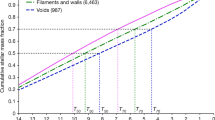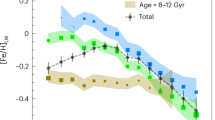Abstract
The large-scale structure of the Universe can be understood in terms of features such as filaments, nodes and walls, which we collectively term the cosmic web. Galaxies evolve within the cosmic web, naturally raising the question of its impact on that process. There are two main mechanisms by which the cosmic web can influence galaxies: one is by modulating the growth of haloes, and the other is by regulating the gas ecosystem around galaxies. Disentangling the two is difficult, but key to deriving a holistic picture of galaxy formation and observational constraints on the growth of haloes. Here we report a detection of the effect of the cosmic web on the galaxy stellar mass–gas-phase metallicity relation of low-redshift star-forming galaxies using data from the Sloan Digital Sky Survey. The proximity of a galaxy to a node, independently of stellar mass and overdensity, influences its gas-phase metallicity, with galaxies closer to nodes displaying higher chemical enrichment than those farther away. We find a similar, but notably weaker, effect with respect to filaments. We find qualitative agreement in the cosmological hydrodynamical simulation IllustrisTNG (TNG300). Using IllustrisTNG, our results can be explained by both halo assembly bias and gas supply combining in nodes in a way that markedly modulates the metallicity of the gas, contributing to the scatter of this fundamental relation in galaxy evolution.
This is a preview of subscription content, access via your institution
Access options
Access Nature and 54 other Nature Portfolio journals
Get Nature+, our best-value online-access subscription
$29.99 / 30 days
cancel any time
Subscribe to this journal
Receive 12 digital issues and online access to articles
$119.00 per year
only $9.92 per issue
Buy this article
- Purchase on Springer Link
- Instant access to full article PDF
Prices may be subject to local taxes which are calculated during checkout






Similar content being viewed by others
Data availability
Data for SDSS DR7 and IllustrisTNG are publicly available at https://wwwmpa.mpa-garching.mpg.de/SDSS/DR7/ and https://www.tng-project.org/data/. DisPerSE catalogues are available from the corresponding author upon reasonable request.
Code availability
DisPerSE is publicly available at: http://www2.iap.fr/users/sousbie/web/html/indexba87.html?category/Install. All other code used in this project is available from the corresponding author upon reasonable request.
References
Wechsler, R. H. & Tinker, J. L. The connection between galaxies and their dark matter halos. Annu. Rev. Astron. Astrophys. 56, 435–487 (2018).
Blanton, M. R. & Moustakas, J. Physical properties and environments of nearby galaxies. Annu. Rev. Astron. Astrophys. 47, 159–210 (2009).
Bond, J. R., Kofman, L. & Pogosyan, D. How filaments of galaxies are woven into the cosmic web. Nature 380, 603–606 (1996).
Dalal, N., White, M., Bond, J. R. & Shirokov, A. Halo assembly bias in hierarchical structure formation. Astrophys. J. 687, 12–21 (2008).
Borzyszkowski, M., Porciani, C., Romano-Díaz, E. & Garaldi, E. ZOMG - I. How the cosmic web inhibits halo growth and generates assembly bias. Mon. Not. R. Astron. Soc. 469, 594–611 (2017).
Musso, M. et al. How does the cosmic web impact assembly bias? Mon. Not. R. Astron. Soc. 476, 4877–4906 (2018).
Paranjape, A., Hahn, O. & Sheth, R. K. Halo assembly bias and the tidal anisotropy of the local halo environment. Mon. Not. R. Astron. Soc. 476, 3631–3647 (2018).
Tojeiro, R. et al. Galaxy And Mass Assembly (GAMA): halo formation times and halo assembly bias on the cosmic web. Mon. Not. R. Astron. Soc. 470, 3720–3741 (2017).
Alpaslan, M. et al. Galaxy And Mass Assembly (GAMA): stellar mass growth of spiral galaxies in the cosmic web. Mon. Not. R. Astron. Soc. 457, 2287–2300 (2016).
Kraljic, K. et al. Galaxy evolution in the metric of the cosmic web. Mon. Not. R. Astron. Soc. 474, 547–571 (2018).
Winkel, N. et al. The imprint of cosmic web quenching on central galaxies. Mon. Not. R. Astron. Soc. 505, 4920–4934 (2021).
Kleiner, D., Pimbblet, K. A., Jones, D. H., Koribalski, B. S. & Serra, P. Evidence for H I replenishment in massive galaxies through gas accretion from the cosmic web. Mon. Not. R. Astron. Soc. 466, 4692–4710 (2017).
Crone Odekon, M. et al. The effect of filaments and tendrils on the H I content of galaxies. Astrophys. J. 852, 142 (2018).
Darvish, B. et al. Spectroscopic study of star-forming galaxies in filaments and the field at z ~ 0.5: evidence for environmental dependence of electron density. Astrophys. J. 814, 84 (2015).
Genel, S. How environment affects galaxy metallicity through stripping and formation history: lessons from the Illustris simulation. Astrophys. J. 822, 107 (2016).
Gupta, A. et al. Chemical pre-processing of cluster galaxies over the past 10 billion years in the IllustrisTNG simulations. Mon. Not. R. Astron. Soc. 477, L35–L39 (2018).
Maiolino, R. & Mannucci, F. De re metallica: the cosmic chemical evolution of galaxies. Astron. Astrophys. Rev. 27, 3 (2019).
Tremonti, C. A. et al. The origin of the mass-metallicity relation: insights from 53,000 star-forming galaxies in the Sloan Digital Sky Survey. Astrophys. J. 613, 898–913 (2004).
De Lucia, G., Xie, L., Fontanot, F. & Hirschmann, M. Gas accretion regulates the scatter of the mass-metallicity relation. Mon. Not. R. Astron. Soc. 498, 3215–3227 (2020).
van Loon, M. L., Mitchell, P. D. & Schaye, J. Explaining the scatter in the galaxy mass-metallicity relation with gas flows. Mon. Not. R. Astron. Soc. 504, 4817–4828 (2021).
Mannucci, F., Cresci, G., Maiolino, R., Marconi, A. & Gnerucci, A. A fundamental relation between mass, star formation rate and metallicity in local and high-redshift galaxies. Mon. Not. R. Astron. Soc. 408, 2115–2127 (2010).
Martini, P. et al. Overview of the Dark Energy Spectroscopic Instrument. In Ground-based and Airborne Instrumentation for Astronomy VII Vol. 10702 (eds Evans, C. J. et al.) 107021F (SPIE, 2018).
York, D. G. et al. The Sloan Digital Sky Survey: technical summary. Astrophys. J. 120, 1579–1587 (2000).
Abazajian, K. N. et al. The Seventh Data Release of the Sloan Digital Sky Survey. Astrophys. J. Suppl. 182, 543–558 (2009).
Strauss, M. A. et al. Spectroscopic target selection in the Sloan Digital Sky Survey: the main galaxy sample. Astrophys. J. 124, 1810–1824 (2002).
Peng, Y.-j & Maiolino, R. The dependence of the galaxy mass-metallicity relation on environment and the implied metallicity of the IGM. Mon. Not. R. Astron. Soc. 438, 262–270 (2014).
Chartab, N. et al. The MOSDEF Survey: environmental dependence of the gas-phase metallicity of galaxies at 1.4 ≤ z ≤ 2.6. Astrophys. J. 908, 120 (2021).
Williams, R. J. et al. Dynamics and metallicity of far-infrared selected galaxies. Mon. Not. R. Astron. Soc. 443, 3780–3794 (2014).
Libeskind, N. I. et al. Tracing the cosmic web. Mon. Not. R. Astron. Soc. 473, 1195–1217 (2018).
Nelson, D. et al. First results from the IllustrisTNG simulations: the galaxy colour bimodality. Mon. Not. R. Astron. Soc. 475, 624–647 (2018).
Pillepich, A. et al. Simulating galaxy formation with the IllustrisTNG model. Mon. Not. R. Astron. Soc. 473, 4077–4106 (2018).
Springel, V. et al. First results from the IllustrisTNG simulations: matter and galaxy clustering. Mon. Not. R. Astron. Soc. 475, 676–698 (2018).
Tumlinson, J., Peeples, M. S. & Werk, J. K. The circumgalactic medium. Annu. Rev. Astron. Astrophys. 55, 389–432 (2017).
Gunn, J. E. et al. The Sloan Digital Sky Survey photometric camera. Astrophys. J. 116, 3040–3081 (1998).
Smee, S. A. et al. The Multi-object, fiber-fed spectrographs for the Sloan Digital Sky Survey and the Baryon Oscillation Spectroscopic Survey. Astrophys. J. 146, 32 (2013).
Salim, S. et al. UV star formation rates in the local Universe. Astrophys. J. Suppl. 173, 267–292 (2007).
Torrey, P. et al. The evolution of the mass-metallicity relation and its scatter in IllustrisTNG. Mon. Not. R. Astron. Soc. 484, 5587–5607 (2019).
Sousbie, T. The persistent cosmic web and its filamentary structure - I. Theory and implementation. Mon. Not. R. Astron. Soc. 414, 350–383 (2011).
Sousbie, T., Pichon, C. & Kawahara, H. The persistent cosmic web and its filamentary structure - II. Illustrations. Mon. Not. R. Astron. Soc. 414, 384–403 (2011).
Kraljic, K. et al. The impact of the connectivity of the cosmic web on the physical properties of galaxies at its nodes. Mon. Not. R. Astron. Soc. 491, 4294–4309 (2020).
Acknowledgements
Part of this work made use of the Horizon cluster hosted by the Institut d’Astrophysique de Paris. We thank S. Rouberol for running it smoothly. K.K. acknowledges support from the DEEPDIP project (grant number ANR-19-CE31-0023). Funding for the Sloan Digital Sky Survey IV was provided by the Alfred P. Sloan Foundation, the US Department of Energy Office of Science and the Participating Institutions. The SDSS acknowledges support and resources from the Center for High-Performance Computing at the University of Utah. The SDSS web site is www.sdss.org. The SDSS is managed by the Astrophysical Research Consortium for the Participating Institutions of the SDSS Collaboration including the Brazilian Participation Group, the Carnegie Institution for Science, Carnegie Mellon University, Center for Astrophysics ∣ Harvard & Smithsonian (CfA), the Chilean Participation Group, the French Participation Group, Instituto de Astrofísica de Canarias, The Johns Hopkins University, Kavli Institute for the Physics and Mathematics of the Universe (IPMU)/University of Tokyo, the Korean Participation Group, Lawrence Berkeley National Laboratory, Leibniz Institut für Astrophysik Potsdam (AIP), Max-Planck-Institut für Astronomie (MPIA Heidelberg), Max-Planck-Institut für Astrophysik (MPA Garching), Max-Planck-Institut für Extraterrestrische Physik (MPE), National Astronomical Observatories of China, New Mexico State University, New York University, University of Notre Dame, Observatório Nacional/MCTI, The Ohio State University, Pennsylvania State University, Shanghai Astronomical Observatory, United Kingdom Participation Group, Universidad Nacional Autónoma de México, University of Arizona, University of Colorado Boulder, University of Oxford, University of Portsmouth, University of Utah, University of Virginia, University of Washington, University of Wisconsin, Vanderbilt University and Yale University.
Author information
Authors and Affiliations
Contributions
C.T.D. performed the main analysis of the data. C.T.D., R.T. and K.K. interpreted the results and contributed to the writing of the manuscript. K.K. generated the DisPerSE catalogues.
Corresponding author
Ethics declarations
Competing interests
The authors declare no competing interests.
Peer review
Peer review information
Nature Astronomy thanks the anonymous reviewers for their contribution to the peer review of this work
Additional information
Publisher’s note Springer Nature remains neutral with regard to jurisdictional claims in published maps and institutional affiliations.
Supplementary information
Supplementary Information
Supplementary Information and Figs. 1–3.
Rights and permissions
About this article
Cite this article
Donnan, C.T., Tojeiro, R. & Kraljic, K. The role of the cosmic web in the scatter of the galaxy stellar mass–gas metallicity relation. Nat Astron 6, 599–606 (2022). https://doi.org/10.1038/s41550-022-01619-w
Received:
Accepted:
Published:
Issue Date:
DOI: https://doi.org/10.1038/s41550-022-01619-w



